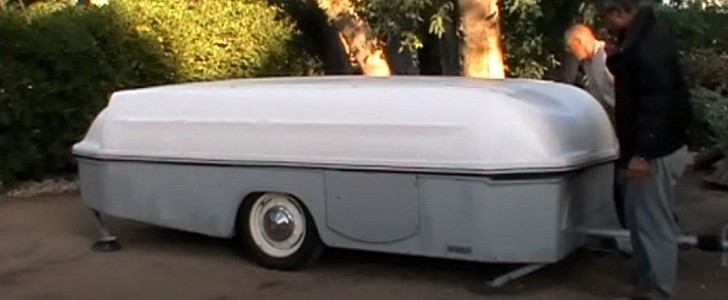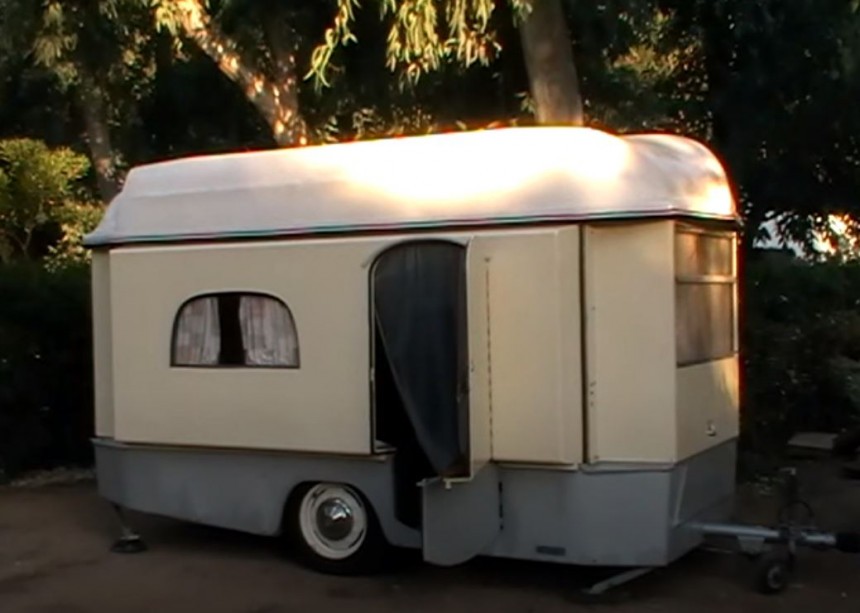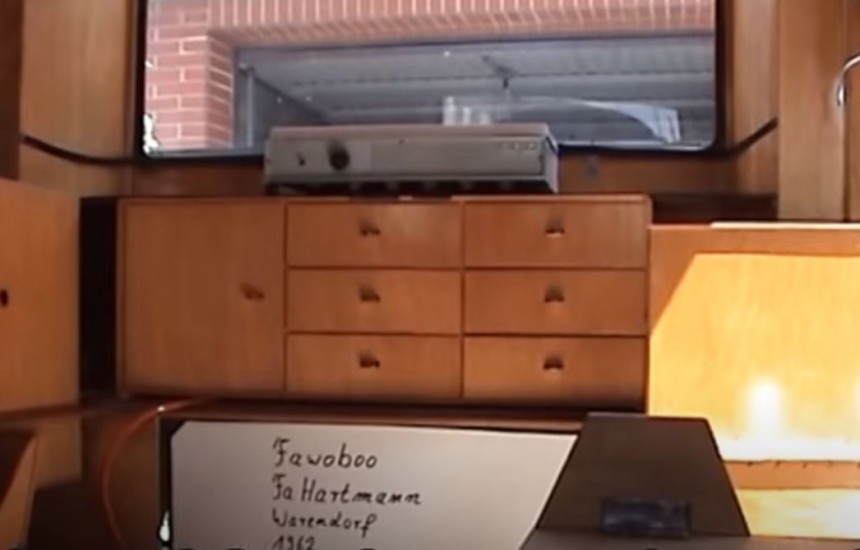Modern man is a creature of habit, accustomed to the basics, at the very least, in terms of modern life commodities. Things were considerably much simpler in the late 1950s and the early 1960s. It’s called progress.
Back in the day when glass-reinforced plastic (GPR) was considered the solution to a myriad of problems, the auto industry and associated businesses really explored its usefulness and reliability. Campers were no exception, with a slew of small-time fabricators seeing an opening in a market they did not have access to before. Their products never reached full-scale production and, almost as a rule, faded away in the following years, but some of these units survive to this day. They are true time capsules, and worthy of your attention.
One such time capsule is the 1962 FaWoBoo camper, also known as the Hartmann FaWoBoo. The first prototype for what became the FaWoBoo in 1961 was the Falter in 1953, which was produced by wheelwright Josef Hartmann from Germany, after spending a very wet night on the road with other sales representatives. A tent replacement was needed, and Hartmann set out to create it for salespeople and vacationing families.
The Falter V became the FaWoBoo in 1961, and was in production until 1965, though the largest number of units was sold in the ‘63-’64 production run. In total, a little over 50 units were sold, of which less than eight are believed to have survived today. One that is actually a spinoff on the original model is found at the Erwin-Hymer-Museum in Germany, if you’re ever in the area. In 1965, the designs for the FoWoBoo were sold to a Finnish company, and 10 more units were produced under the name Fiskars Kotillo (“snail shell”).
Using GPR, the FaWoBoo was designed as a transformable camper that aimed to be the perfect holiday solution for an entire family, offering overnight accommodation and the basics, and also the luxury of a boat that could be outfitted with an outboard. Like the Caraboot we discussed last November, the FaWoBoo had a roof that doubled as a boat.
But the FaWoBoo had a little something extra to the Caraboot: a very low profile in road mode. This was a transformable slash foldable camper that, tucked neatly away, measured just 116 cm (45.6 inches) in height. It was also light, with a curb weight of 450 kg (992 pounds), which offered the possibility to pack an extra 150 kg (331 pounds) of stuff in it, and which made it perfect to be towed by the family car. You didn’t have to invest in a second vehicle for towing, because the daily did the job just fine.
The name FaWoBoo sounds funny, but only to the untrained eye. It actually stands for Fahren Wohnen Boot, which means “driving living boat,” more or less. It was chosen to emphasize the three hottest selling points of the camper: easy towability, fancy living on the road, and the integrated boat. When it was first introduced, it came with a price tag of 5,760 German Deutsche Marks, which is roughly $3,355 at the current exchange rate.
The interior of the FaWoBoo was made of plywood and came bare. You could get extra stuff like a burner, heating, or paddles or an outboard for the boat if you paid extra. Assembly took under 10 minutes, with each wall sliding upwards on hinges, and secured in place. The two side walls tucked inside, with everything else pushed underneath them. In other words, once the walls of the FaWoBoo were in place, you had to solve the “puzzle” of the interior, by bringing up cabinets and securing them, and arranging the seats.
It was probably a time-consuming task but, at the end of it, you got a camper that offered twin beds, or a full-size bed with a toddler’s cot and an extra bunk bed, a table, and just the bare minimum to throw together a meal. One of the walls could also extend out and sit on legs like an awning, or you could take the roof to go boating, and extend the replacement tarpaulin to create an outdoor dining area.
Granted, by today’s standards, the FaWoBoo was a plastic box with some resemblance of a camper. But it offered protection from the elements and it did so in a lightweight and low-profile form factor that made it easy to tow and easy to store when not in use. It was also pretty fancy for those times, with curtains on the windows and the cutest, tiny plastic door – not to mention that boat that could hold six people for an entire day of fun on the water.
One such time capsule is the 1962 FaWoBoo camper, also known as the Hartmann FaWoBoo. The first prototype for what became the FaWoBoo in 1961 was the Falter in 1953, which was produced by wheelwright Josef Hartmann from Germany, after spending a very wet night on the road with other sales representatives. A tent replacement was needed, and Hartmann set out to create it for salespeople and vacationing families.
The Falter V became the FaWoBoo in 1961, and was in production until 1965, though the largest number of units was sold in the ‘63-’64 production run. In total, a little over 50 units were sold, of which less than eight are believed to have survived today. One that is actually a spinoff on the original model is found at the Erwin-Hymer-Museum in Germany, if you’re ever in the area. In 1965, the designs for the FoWoBoo were sold to a Finnish company, and 10 more units were produced under the name Fiskars Kotillo (“snail shell”).
But the FaWoBoo had a little something extra to the Caraboot: a very low profile in road mode. This was a transformable slash foldable camper that, tucked neatly away, measured just 116 cm (45.6 inches) in height. It was also light, with a curb weight of 450 kg (992 pounds), which offered the possibility to pack an extra 150 kg (331 pounds) of stuff in it, and which made it perfect to be towed by the family car. You didn’t have to invest in a second vehicle for towing, because the daily did the job just fine.
The name FaWoBoo sounds funny, but only to the untrained eye. It actually stands for Fahren Wohnen Boot, which means “driving living boat,” more or less. It was chosen to emphasize the three hottest selling points of the camper: easy towability, fancy living on the road, and the integrated boat. When it was first introduced, it came with a price tag of 5,760 German Deutsche Marks, which is roughly $3,355 at the current exchange rate.
The interior of the FaWoBoo was made of plywood and came bare. You could get extra stuff like a burner, heating, or paddles or an outboard for the boat if you paid extra. Assembly took under 10 minutes, with each wall sliding upwards on hinges, and secured in place. The two side walls tucked inside, with everything else pushed underneath them. In other words, once the walls of the FaWoBoo were in place, you had to solve the “puzzle” of the interior, by bringing up cabinets and securing them, and arranging the seats.
Granted, by today’s standards, the FaWoBoo was a plastic box with some resemblance of a camper. But it offered protection from the elements and it did so in a lightweight and low-profile form factor that made it easy to tow and easy to store when not in use. It was also pretty fancy for those times, with curtains on the windows and the cutest, tiny plastic door – not to mention that boat that could hold six people for an entire day of fun on the water.














